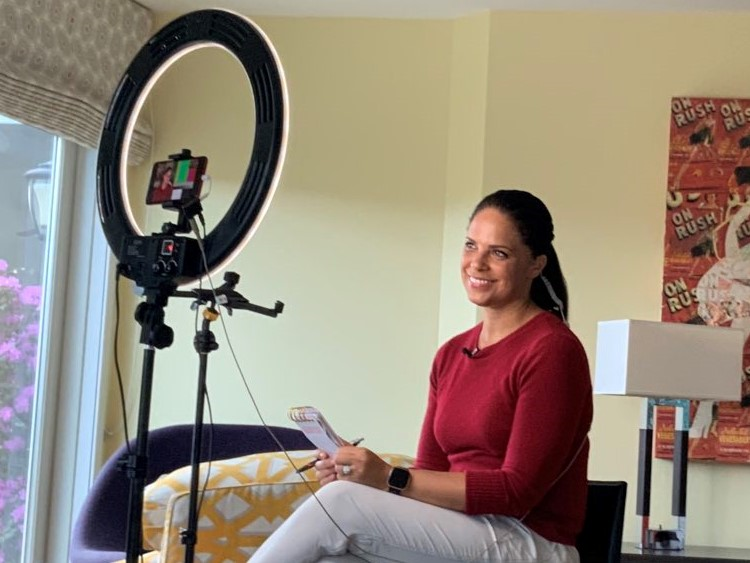Pajamas, Dangling Cords, and Other No-No’s for Virtual Candidates
These days, hand-shaking, baby kissing, and door-knocking are scary and flout social distancing rules. The traditional ways candidates literally reach out and touch voters have been put on hold due to the coronavirus. No more direct contact means it’s necessary to master the art of being a virtual candidate.
Making the shift to online campaigning isn’t as easy as it may appear to be. Ask Joe Biden. His initial foray with a virtual town hall was marred by garbled audio that prevented viewers from hearing his message about fighting the pandemic.
For candidates up and down the ballot, reaching voters requires a vibrant online presence. It shouldn’t be overly produced, nor does it need to be perfect. But it should reflect who you are and why you’re ready to serve. I’ve been coaching women candidates for twenty years and here are my six top points on how to present your best virtual self.
- Give Yourself Credit for Persevering
Campaigning is hard work and doubly so now. In this health crisis, candidates, like voters, are juggling home-schooling demands and work cutbacks or job losses with anxiety about loved ones. Delayed primary election dates have also wreaked havoc on schedules. Amid the chaos, you deserve praise for staying focused on running. Women and people of color remain woefully underrepresented at all levels and that will change only with people like yourself stepping up.
- Set Up a Home Studio
Selecting the right location and camera equipment is easy, preventing the dog from barking while you’re using them isn’t. A quiet room with low traffic flow such as a bedroom or basement will help reduce the likelihood of interruptions by antsy kids. City Councilor Michelle Wu was being interviewed by Boston 25 News at home when her kids burst in. It happens! Be prepared to share your multi-tasking skills to create a connection with anyone facing a similar predicament.
Your daily smile. Being a working mom is tough. Working from home can be a challenge. @wutrain spoke to us today about rent relief for Boston residents - it's a serious story that will air this evening on @boston25 but here are some outtakes that are just too good not to share. pic.twitter.com/1Ebh8mTzLJ
— Elysia Rodriguez (@ElysiaBoston25) April 9, 2020
The backdrop or area behind you that is visible to viewers presents an opportunity to send a message. The bookcases behind the councilwoman are a safe choice. Consider the strategic placement of a family photo or two. Or a campaign sign. But the focus of the frame should always be you, so clear away clutter like coffee cups, wine glasses (!), or messy stacks of paper.
- The Right Stuff
There are two pieces of equipment you need to purchase – an IFB ear piece and a light kit. The IFB plugs directly into your smartphone or desk top and provides good quality audio for interactive events such as video conferences or media appearances. The earpieces are barely visible, thus less distracting than white cords or bulky headphones. They are about 10 dollars and can be ordered online. (Another inexpensive, online purchase to invest in is a tripod if you plan to use your phone.)
Do yourself a favor and add supplement lighting. Avoid harsh fluorescents and direct sunlight. Sitting with a window behind you will result in dark shadows obscuring your face. Bright sunlight from the front can wash you out. An affordable choice is a ring light like the one shown in the photo with newscaster Soledad O’Brien in her home studio. It adds soft, diffused light that fills in shadows and flatters the face.

- Test. Record. Playback.
It is imperative to test drive the equipment before going live with an audience. Experiment with camera angles so that the camera shoots your best side. Most people look better with a slightly angled shot rather than straight on. Position the light so that it also comes in from the side. If there is a window, sit so that indirect light comes from the other side. A shear curtain will soften any glare. The mic on your phone or desktop should do the job. Carpeted floors and fabric drapes absorb sound and can reduce echoes or a tinny sound.
With everything in place, record a rehearsal then play it back to see how it looks. You may need to adjust the placement of the camera or light. Do another run-through to check timing. Online you are competing with creative 15-second TikToks. Social media posts should clock in under 60 seconds and bio pieces and donor appeals no longer than five minutes.
- Relevant Messaging
The only thing people care about right now is the pandemic and your message must reflect that. If you are an incumbent, talk about the actions you’re taking. The crisis has given many people a greater appreciation for the important role state and local government play in their lives. The decision by Oregon Governor Kate Brown to send 140 life-saving ventilators to hard hit New York showed leadership and compassion. If you are a first-time candidate, share an example of your problem-solving ability. Voters are looking for leaders who can work with others to get things done and who will tell them the truth.
During the Great Depression, FDR spoke directly to the public with fireside chats. The president’s intimate radio broadcasts utilized the mass media technology of the day to reach people in their homes and are credited with reassuring the public and preventing a run on the banks. Regular social media posts can offer inspiration, suggestions on ways to help others, and lift up stories of neighbors helping neighbors.
- Look Good to Do Good
Claire McCaskill purposefully posted this photo of herself looking like a pro above the waist while wearing PJ bottoms. As a former U.S. Senator, she can get away with it but you shouldn’t risk it. A less than serious look can undermine an attempt to convey a serious message especially when the most viewers don’t know who you are.
Behind the scenes in my kitchen “studio”. It was early...Ignore the pajama pants please.
@Morning_Joe pic.twitter.com/QtN76bXhfJ— Claire McCaskill (@clairecmc) April 9, 2020
Wear a complete look – you’ll feel more on. And if a camera shot goes wide, you won’t be embarrassed. The basics include outfits in solid colors like what former gubernatorial candidate Stacey Abrams is wearing below. Purple and rich colors show up well on-camera. Avoid large, shiny pieces of jewelry. Beads or pearls are better choices. Makeup should include undereye concealer, foundation, powder, and matte lipstick.

In this new world order, be assured that with preparation you can carry on a virtual campaign. Here is some inspiration from state legislative candidates in Texas. Their campaign video is clever, energetic, and it follows all of the social distancing guidelines.
Woke up early feeling like I just may run for State Representative!!- @Lizzo... Shoutout to my girls running for the #txlege: @AkilahBacy @NataliforTexas @alisafortexas #FlipTheTexasHouse #RunLikeAGirl #StayAtHome pic.twitter.com/h07RhSI3Jc
— Elizabeth Beck (@elizabethforTX) April 8, 2020


